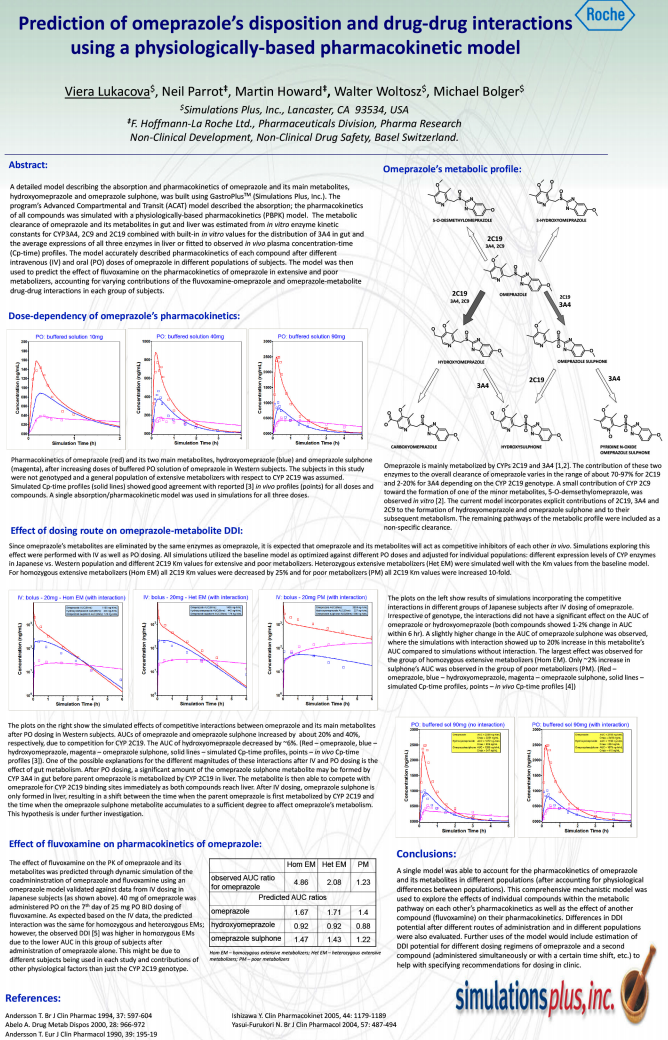To fit an absorption-pharmacokinetic model for simulation of tobramycin in adult and pediatric populations. Tobramycin pulmonary absorption and pharmacokinetics were simulated using GastroPlus™.

Physiologically-based pharmacokinetic {PBPK) models for prediction of time-dependent enzyme inhibition (TDI): effect of diltiazem on midazolam and quinidine
Purpose of the study was to optimize a PBPK model to predict timedependent and competitive inhibition of CYP 3A4 by diltiazem...

Development of A Mechanistic in vitro – in vivo Correlation for Theophylline
Theophylline is used to prevent and treat wheezing, shortness of breath, and difficulty breathing caused by asthma, chronic bronchitis, emphesema, and other lung diseases. Immediate release oral…

Application of a Respiratory PBPK Model for Predicting Deposition and Disposition following Inhaled Administration of Morphine
Demonstrate the pulmonary component of the GastroPlus™ Additional Dosage Routes Module™ (ADRM) simulation to develop a pharmacokinetic (PK) and pharmacodynamic (PD) model for inhaled…

Mechanistic PBPK Simulation in Place of In Vivo Drug-Drug Interaction (DDI) Studies for Compliance with Regulatory Requirements of EMA and FDA
To highlight the application and validation of PBPK DDI simulation results obtained using GastroPlus™ in compliance with newly proposed European Medicines Agency (EMA) and US FDA guidelines for the…

Beyond Filters: ADMET Risk™ for Multi-objective Drug Development
We calculated predictions for over 30 properties relevant to absorption, distribution, metabolism, excretion and toxicity (ADMET) for a large and pharmaceutically pertinent...

Forensic Pharmacometrics: Part 2 – Deliverables for Regulatory Submission
As modeling and simulation results become increasingly integral to critical development-related decision-making and program outcomes, the consequences of poor documentation of pharmacometric analyses can…

Physiologically-Based Pharmacokinetic (PBPK) Modeling of Diltiazem-Midazolam Drug-Drug Interaction (DDI)
The purpose of this modeling effort was to explore the effects of various processes and physiological parameters on the DDI involving competitive and time-dependent inhibition (TDI). Absorption and…

Single-Dose And Steady-State Pharmacokinetics Of Moxduo™, A Dual-Opioid Formulation Containing A Fixed Ratio Of Morphine And Oxycodone
Q8003 (MoxDuo™) is the first dual-opioid combination product that has been evaluated in clinical trials. MoxDuo immediate-release capsules were developed for the management of acute moderate to severe…

Semi-mechanistic PK/PD Model of the Effect of Odanacatib, a Cathepsin K Inhibitor, on Bone Turnover to Characterize Lumbar Spine Bone Mineral Density in Two Phase II Studies of Postmenopausal Women
Odanacatib (MK-0822), a potent, orally-active inhibitor of cathepsin K, is under clinical development for treatment of postmenopausal osteoporosis. This poster describes base model development of a…

Prediction of Omeprazole’s Disposition and Drug-Drug Interactions Using A Physiologically-Based Pharmacokinetic Model
Download the poster presented at the ADMET Europe 2010 conference on the development of PBPK models and prediction of parent & metabolite DDIs with omeprazole.

Simulations of the Drug-Drug Interaction Between Atomoxetine and Quinidine in Poor and Extensive CYP2D6 Metabolizers
Atomoxetine is indicated for attention-deficit hyperactivity disorder (ADHD) in children, adolescents and adults. It is metabolized to 4- hydroxy-atomoxetine primarily by CYP2D6, which is known to have…

Population Pharmacokinetics of Dexmedetomidine (DEX) During Long-Term Continuous Infusion in Critically Ill Patients
Dexmedetomidine (DEX), a selective alpha2-adrenoceptor agonist is approved for sedation. In this study, the population pharmacokinetics (PK) of DEX during long-term (> 24 hours) infusion was…

A Systems Approach to Resource Allocation in an Integrated Research and Development Environment
Typically, at the beginning of a project, the scope is defined along with the timelines and budget. As project team leaders negotiate with functional managers to recruit key team members, including…

Semi-mechanistic PK/PD Model of the Effect of Odanacatib, a Cathepsin K Inhibitor, on Bone Turnover to Characterize Lumbar Spine Bone Mineral Density in Two Phase II Studies of Postmenopausal Women
Odanacatib (MK-0822), a potent, orally-active inhibitor of cathepsin K, is under clinical development for treatment of postmenopausal osteoporosis. This poster describes base model development of a...

Development of a Physiologically Based Pharmacokinetic (PBPK) Model for Predicting Deposition and Disposition follo · g Inhaled and Intranasal Administration
The selection of a biologically active molecule as a successful inhaled therapeutic agent depends on its pharmacokinetic and safety properties...

Modeling Drug Disposition of Timolol in Ocular Tissues of Rabbit following Topical Eye Drops
Recently, we reported the successful application of a novel mathematical model describing drug disposition in eye compartments to simulate disposition of clonidine after topical (eye drop) administration.

Modeling Fluconazole – a Case with Concentration-Dependent Liver:Plasma Partition Coefficient
Fluconazole is an antifungal agent widely used in the clinical setting for the treatment of candidiasis and meningitis. It undergoes minimal metabolism and is excreted renally.

PBPK Modeling of Fluoxetine and its Metabolite Norfluoxetine: Prediction of the Extent of Their Involvement in Drug Interactions
The aim of our study was to simulate the human pharmacokinetics of fluoxetine and its major metabolite, norfluoxetine, and predict the magnitude of their drug-drug interactions (DDIs) using physiologically…

A Pharmacokinetic Simulation-Based Comparison Of Varying Adherence Rates For Paliperidone ER And Risperidone In Patients With Schizophrenia
Medication adherence is important to successful management of • patients with schizophrenia and related psychotic disorders; patient nonadherence is documented in numerous studies (e.g., 30%-35%…
